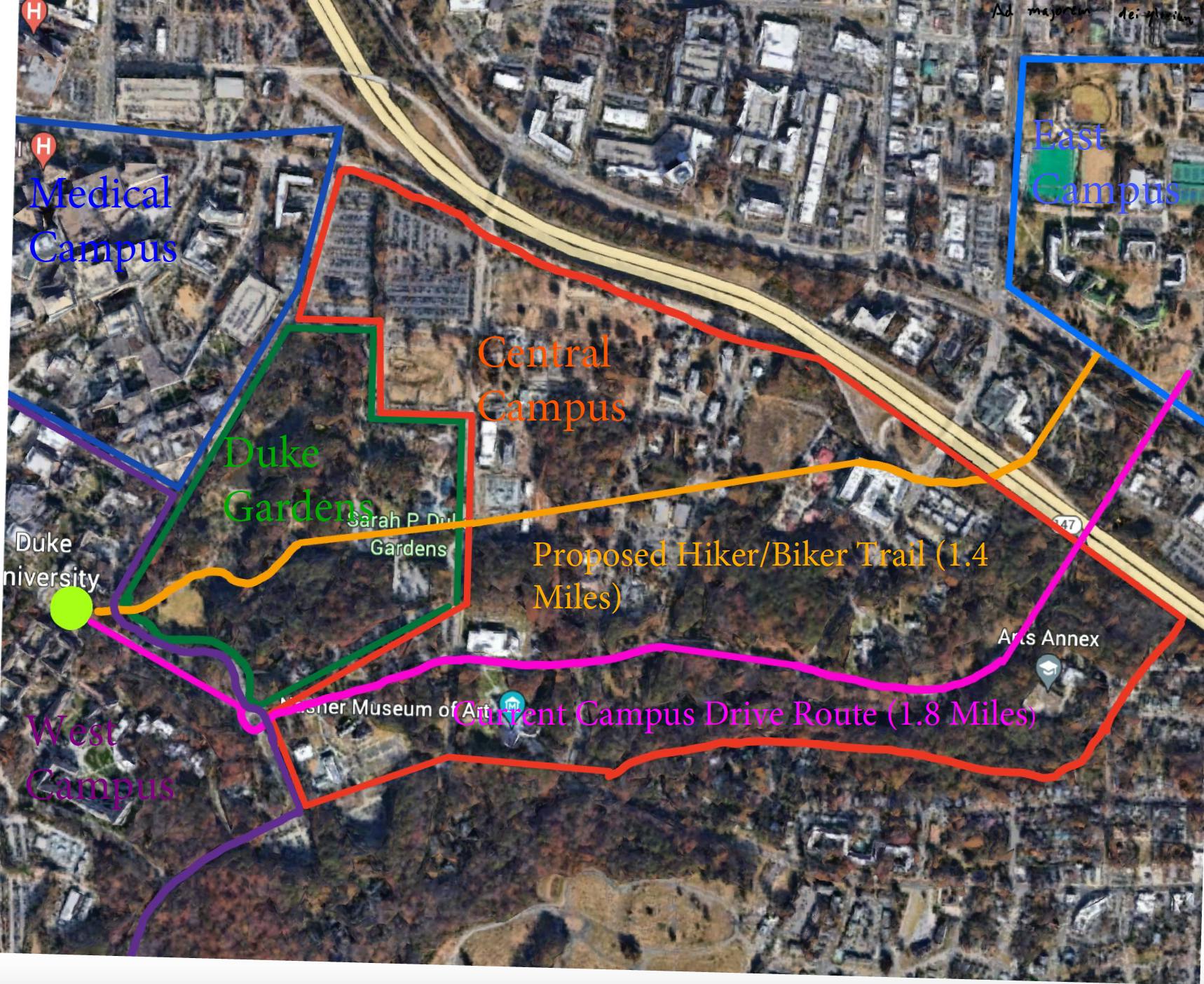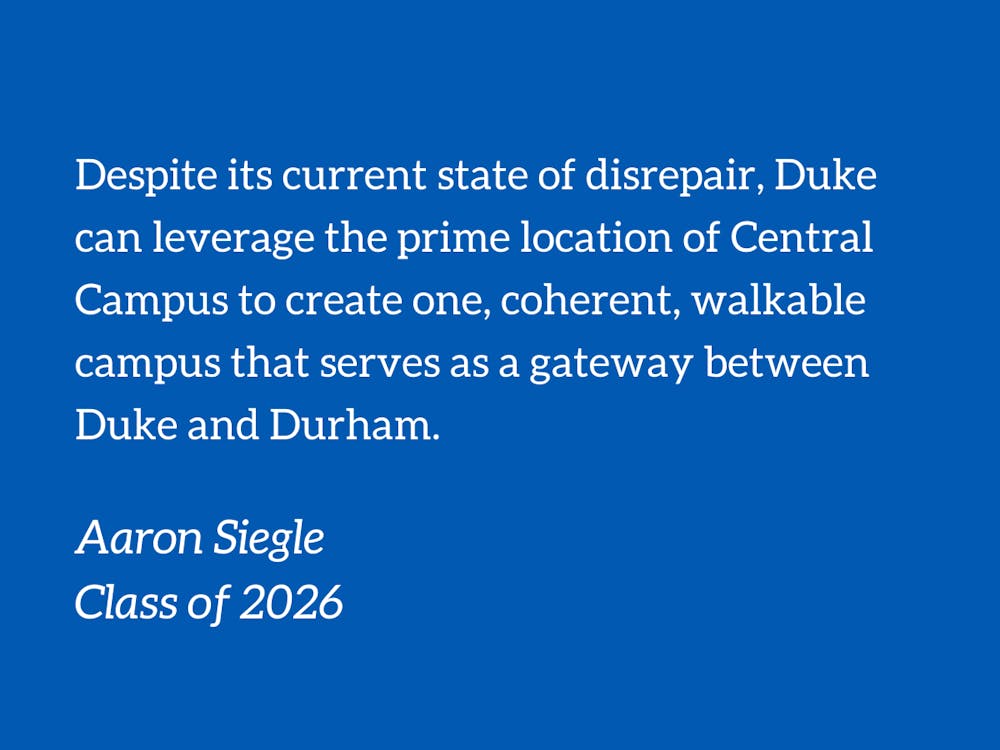After 40 cramped minutes squished in the residual corner of an overpacked C-1, only one obstacle lay in between me and the promised land of West Campus: Ken Jeong.
The celebrity alumnus was luring hordes of students to the Duke Arts Block Party, which happened to be blocking Campus Drive, a critical artery linking East and West Campus. Hence the 40-minute C-1 ride: starting down Campus Drive before encountering Block Party, redoubling back to East, getting stuck in Main Street gridlock, swerving through H-Lot, crawling down Flowers Drive and finally arriving at Abele Quad.
“Where are we?” asked the first years next to me, who erroneously believed the circuitous detour was a part of their Scale and Coin initiation rituals. “We’re on campus,” I replied to skeptical looks. Looking out the window, it sure didn’t look like any college campus, much less the majestic gothic wonderland that is baked into Duke’s identity.
Remnants of buildings — their exposed foundations now overgrown by brambles and weeds — dotted the landscape. Beyond that, a vast sea of inky asphalt, devoid of both cars and people, extended across the horizon. We were at the heart of Central Campus.
Despite its current state of disrepair, Duke can leverage the prime location of Central Campus to create one coherent, walkable campus that serves as a gateway between Duke and Durham. Appealing to pedestrians and cyclists, the establishment of new facilities on Central Campus to support these sustainable modes of transportation will restore vibrancy to this seldom traveled expanse.
Ever since the demolition of the Central Campus Apartments in 2019, Central Campus has struggled to retain substantial foot traffic, which is central (no pun intended) to the success of any college campus or urban district. The apartments, which were constructed in the 1960s before succumbing to mold, generated considerable social engagement that made the area feel more welcoming. While there are many pedestrians along the Campus Drive corridor, few ever deviate onto the streets of Central Campus because why would they? Perhaps to visit the Organization for Tropical Studies (OTS) or the headquarters of HR’s Learning and Organization Development (L&OD) or one other of the hodgepodge of underutilized buildings? Currently, few students see a need to visit Central Campus, keeping it in the perpetual state of campus backwater.
In fact, Central Campus is ideally situated in between multiple pedestrian corridors, making it a great candidate for a walkable community. Believe it or not, Abele Quad is only a mile away from the 9th Street commercial corridor, making the trip a doable walk. Yet, few Duke students would ever consider venturing from West Campus to 9th Street, most likely due to the confusing turns and plethora of parking lots in the way, not to mention the blistering heat and unforgiveable weather. The lack of foot traffic discourages even intrepid pedestrians given that empty streets are perceived as being more dangerous.

Similarly, East Campus is only 1.4 miles away from Abele Quad when traveling in a straight line. Yet the trek to East via Campus Drive is 1.8 miles, unnecessarily swinging south and making the walk impractical for most. Meanwhile, the 1.4-mile route runs adjacent to Duke hospital, Duke Gardens and Swift Apartments, all premier campus destinations. If Duke were to string together these establishments with a hiker-biker trail, students and employees alike would flock to this convenient and sustainable alternative rather than be squished on the C-1 or pay an arm and a leg for parking.
These ingredients for success have made Central Campus a subject of intrigue from urban planners and Duke students for generations. A 2003 master plan reimagines Central Campus as a walkable ‘urban village,’ complete with a monorail connecting it to East and West. Nine years later, another group of urbanists proposed building a mixed-use neighborhood where all essentials would be within a five-minute walk, inspired by Oxford’s legendary High Street. Last year, Duke Student Government President Lana Gesinsky proposed building a venue for social life as a part of the Fun@Duke initiative.
What about the environment? Wouldn’t Duke have to cut down vast swaths of pristine forest to unlock Central Campus’ potential, as they have for other expansions? Out of the 200 acres on Central Campus, 31 are allocated to parking lots and 32 I classify as ‘urban wasteland,’ essentially the ruins of the Central Campus Apartments. Redeveloping these parcels would do little harm to the environment, especially given the role of parking lots as contributors to the urban heat island effect and drivers of Durham’s stormwater management problem.
A Central Campus redevelopment project would bolster Duke’s commitment to sustainability expressed in the Duke Climate Commitment and goal to support Durham via the Office of Durham and Community Affairs. Central Campus serves as a wall separating Duke from Durham, stymieing the exchange of people, commerce and ideas. Turning Central Campus into a haven for pedestrians would suddenly make neighborhoods like Crest Street and Burch Avenue seem tangibly close to West Campus.
While a complete overhaul of Central Campus would radically elevate the Duke experience, it is clear that Duke does not want to spend the money to finance such a large capital campaign, according to the Central Campus Task Force. But there are smaller projects Duke can pursue to make Central Campus more accessible without committing billions of dollars.
First, building a hiker-biker trail between East and West via Swift and Central Campus would reduce congestion, lower commute times and promote sustainability. Second, constructing amenities such as a social venue, a second Duke Campus Farm location and a small-scale commercial corridor along Erwin Road would induce to students to venture onto Central, binding it to the rest of campus. And finally, investing in low-cost pedestrian and bike infrastructure would make the area more welcoming and safer. This would include adding bike lanes along Campus Drive (where heavy bus traffic makes biking difficult) and painting crosswalks over the NC-147 access ramps near Swift Apartments.
Duke is heralded for the iconic, majestic and tranquil ambiance of both East and West Campus. Small investments in Central Campus can elevate it to this standard as well without sacrificing environmental quality. Duke can turn Central Campus from a void dividing East, West and Durham into a hub uniting the three, lifting all three into a new era of dynamism.
Aaron Siegle is a Trinity sophomore. His column typically runs on alternate Fridays.
Get The Chronicle straight to your inbox
Sign up for our weekly newsletter. Cancel at any time.

